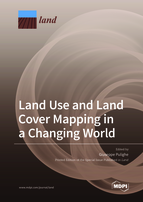Land Use and Land Cover Mapping in a Changing World
A special issue of Land (ISSN 2073-445X). This special issue belongs to the section "Land Systems and Global Change".
Deadline for manuscript submissions: closed (31 May 2022) | Viewed by 59718
Special Issue Editor
Interests: land use; GIS; remote sensing; modelling
Special Issues, Collections and Topics in MDPI journals
Special Issue Information
Dear Colleagues,
Land use and land cover changes are well documented in their intensity, spatial occurrence and magnitude, and the rate of these changes is increasingly impacting on ecosystems and human society, human livelihoods and wellbeing.
Land use and land cover change mapping can play an important role in planning and management of our world, guiding transformative changes of the landscape for a sustainable future. Mapping spatio-temporal dynamics of both human societies and natural environments are illustrative for policy-makers, decision-makers and stakeholder, and promise to capture and relate spatial trajectories into strategic and value-added information.
We encourage authors to submit contributions in the following priority areas to this Special Issue of Land:
- Multi-disciplinary research that evaluates land use and land cover changes through a socio-ecological lens, to help understand and unpack ongoing trends, and identify elements acting as game changers in either facilitating or hindering transformative change.
- Multi-disciplinary research that evaluates how land use and land cover changes under future scenarios can be used in supporting policy decisions and guiding transformative changes.
- Multi-disciplinary research that investigates the taken up by either institutions or individuals of the increasingly available social and biophysical mapping tools for decision making and land management.
Dr. Giuseppe Pulighe
Guest Editor
Acknowledgments
We are very grateful to the original Guest Editor, Dr. Claudia Capitani, for her significant contribution to this Special Issue. Due to work commitments, the Guest Editor of this Special Issue has changed to Dr. Giuseppe Pulighe who is now leading this project.
Manuscript Submission Information
Manuscripts should be submitted online at www.mdpi.com by registering and logging in to this website. Once you are registered, click here to go to the submission form. Manuscripts can be submitted until the deadline. All submissions that pass pre-check are peer-reviewed. Accepted papers will be published continuously in the journal (as soon as accepted) and will be listed together on the special issue website. Research articles, review articles as well as short communications are invited. For planned papers, a title and short abstract (about 100 words) can be sent to the Editorial Office for announcement on this website.
Submitted manuscripts should not have been published previously, nor be under consideration for publication elsewhere (except conference proceedings papers). All manuscripts are thoroughly refereed through a single-blind peer-review process. A guide for authors and other relevant information for submission of manuscripts is available on the Instructions for Authors page. Land is an international peer-reviewed open access monthly journal published by MDPI.
Please visit the Instructions for Authors page before submitting a manuscript. The Article Processing Charge (APC) for publication in this open access journal is 2600 CHF (Swiss Francs). Submitted papers should be well formatted and use good English. Authors may use MDPI's English editing service prior to publication or during author revisions.
Keywords
- Decision-making support
- Scenarios
- Web-mapping tools
- Transdisciplinary
- Agricultural land change
- Urbanl land changes
- Forest land changes






